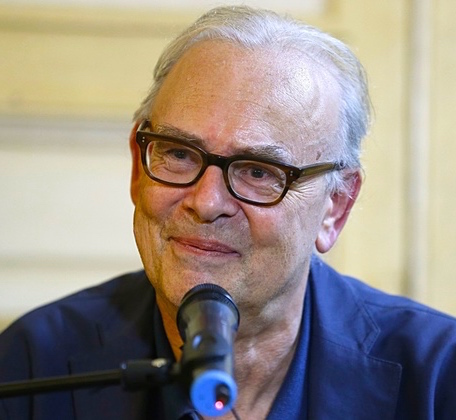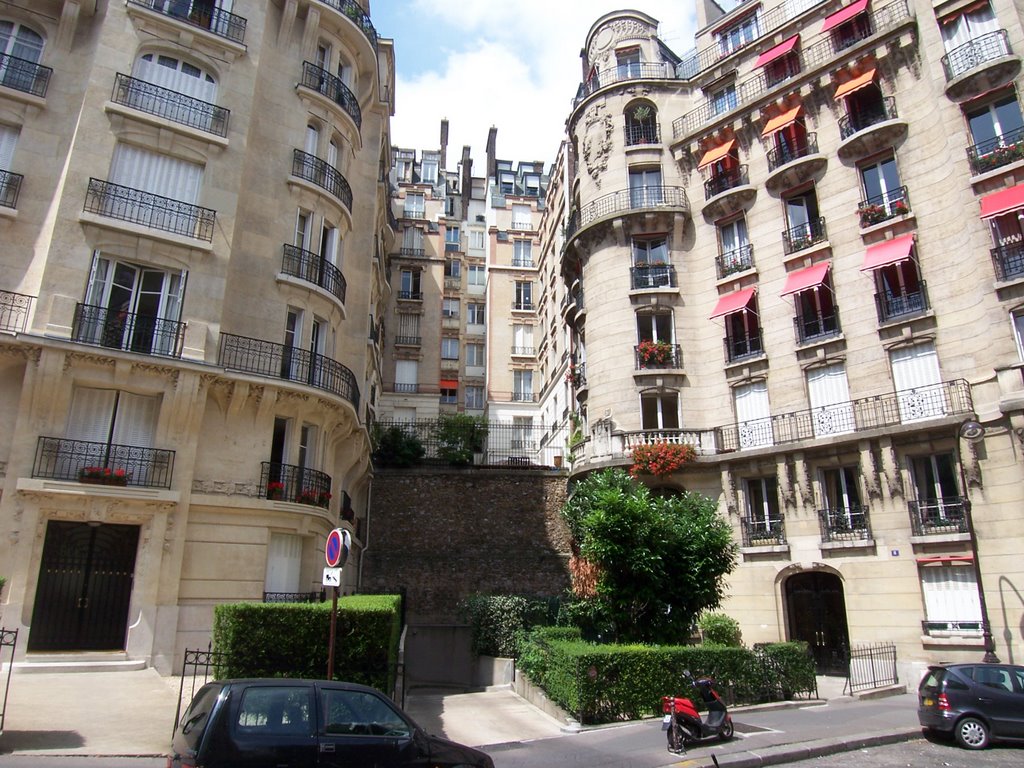Note: Patrick Modiano was WINNER of the Nobel Prize for Literature in 2014 and has been WINNER of many other prizes in Europe. When his Nobel Prize was awarded, he was almost unknown in the US, and publishers have been working overtime to make his many novels available here.
“They say that smells bring back the past best, and the smell of ether always had a curious effect on me. It seemed to be the very essence of my childhood, but as it was bound up with sleep and the numbing of pain, the images that it unveiled clouded over again almost simultaneously. It was surely because of this that my childhood memories were so confused. Ether made me both remember and forget.”
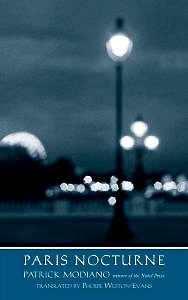 Remembering and forgetting underlie many of French author Patrick Modiano’s stories as he creates almost dreamlike images and sequences which fade in and out as the time frame changes, often unexpectedly. New images and memories seem to force themselves into his consciousness, only to vanish back into the netherworld from which they have come. Almost as famous for the bizarre and often cruel life he experienced as a child as he is for his Nobel Prize for Literature, Modiano, through his novels, mines his own past for clues as to who he was and who and what he has become. Repeating images and events include references to his absent parents and the circus people with whom he once stayed, some of whom engaged in unlawful activities, reinforcing the idea that the only love and care Modiano knew as a child came from strangers. His parents had no real interest in him after his birth in 1945, his mother traveling the world as a second-rate actress and his father continuing the black marketeering in which he engaged during World War II. His father’s world travels to obtain black market goods kept him out of the country for long periods of time in the postwar era and left Patrick and his younger brother Rudy unattended except for hired caretakers like the circus employees whom his father paid to look after them for several years.
Remembering and forgetting underlie many of French author Patrick Modiano’s stories as he creates almost dreamlike images and sequences which fade in and out as the time frame changes, often unexpectedly. New images and memories seem to force themselves into his consciousness, only to vanish back into the netherworld from which they have come. Almost as famous for the bizarre and often cruel life he experienced as a child as he is for his Nobel Prize for Literature, Modiano, through his novels, mines his own past for clues as to who he was and who and what he has become. Repeating images and events include references to his absent parents and the circus people with whom he once stayed, some of whom engaged in unlawful activities, reinforcing the idea that the only love and care Modiano knew as a child came from strangers. His parents had no real interest in him after his birth in 1945, his mother traveling the world as a second-rate actress and his father continuing the black marketeering in which he engaged during World War II. His father’s world travels to obtain black market goods kept him out of the country for long periods of time in the postwar era and left Patrick and his younger brother Rudy unattended except for hired caretakers like the circus employees whom his father paid to look after them for several years.
In this newly translated novel from 2003, Modiano depicts a main character, remarkably like himself, as a twenty-year-old walking late at night, when a car emerges from the darkness and grazes his leg from knee to ankle, then crashes. A woman stumbles out of the driver’s seat, and she and the speaker are ushered into a nearby hotel lobby to await a police van and medical help. From the outset, the circumstances of this accident are unclear. A very large, brown-haired man walks over and sits across from them in the lobby, coldly staring at them. The speaker has lost a shoe, he thinks, though he also says he “could no longer tell whether I’d lost a shoe or an animal, the dog from my childhood that had been run over when I lived on the outskirts of Paris.” He believes that sometime in the past he knew the woman who has hit him. On the way to the “casualty department of the Hotel-Dieu,” he loses his voice; the big man talks intimately with the woman driver; and eventually a medic of some kind puts a mask over the speaker’s face, then turns on the ether.
These fragmentary memories continue as the speaker begins to awaken from the ether. He thinks the big, brown-haired man, sounding like a robot, has shown him a photograph asking if he recognizes the subject. He has the impression that he is in a hotel in the mountains and that the woman driving the car during the accident once lived down the hall from him. His missing shoe turns up. Then, strangely, the big man brings him an envelope, its contents a complete surprise, and has him sign a report admitting to the circumstances of the accident and his own role. When the speaker is released from treatment, he decides to call on Jacqueline Beausergent, the female driver, if he can find her apartment in the Square de l’Alboni.
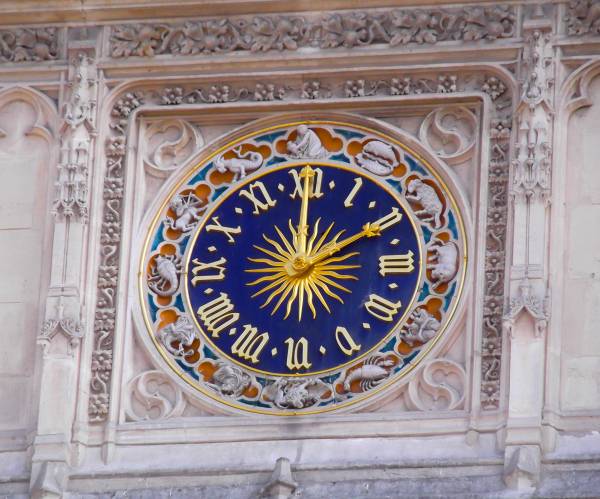
As he awaits his father for a meeting, the speaker hears the clock from Saint-Germain-l’Auxerrois striking the quarter-hours. Photo by Arielle
The flashbacks and flashforwards begin seemingly at random, as he recalls his father’s cruelty on the rare occasions he saw him and also meets a philosopher who runs classes for his student disciples. He meets a girl, a music teacher, then suddenly finds himself, thirty years later, overhearing another familiar name from the past on the loudspeaker at Orly Airport, at which point he races to find the person. Time before and after the accident become confused, as the same or similar images and memories appear and reappear, and names in one time period reappear in another. As an adult, he begins to make associations with another accident he had when he was a child. By the end of the novel, he is convinced that the answers to many of the mysteries haunting his life can be found if he can only find a missing “sea-green Fiat.”
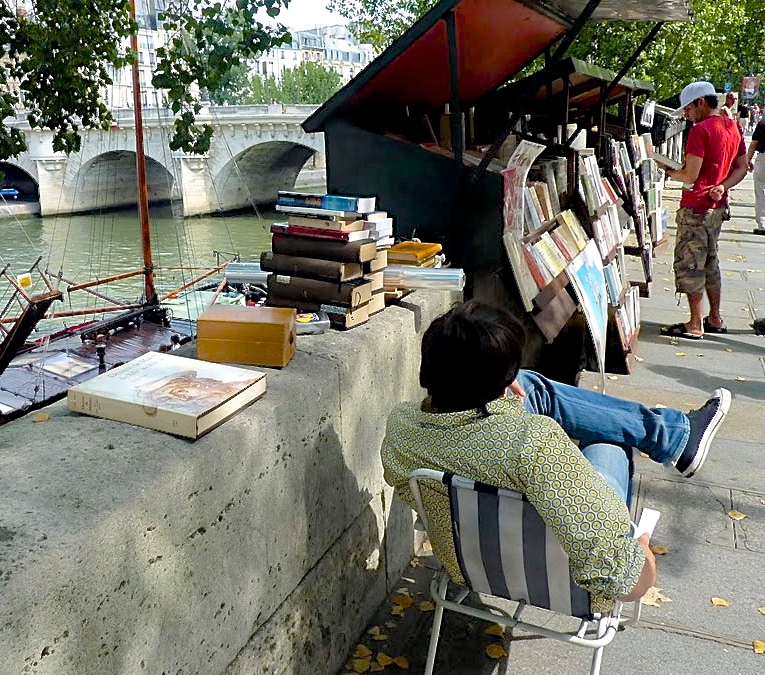
Among Les Bouquinistes, booksellers, on the left bank at the Quay de la Tournelle, the speaker finds three books by Fred Bouviere, a guru popular among students at the time.
The speaker’s earnest search for missing pieces and answers to his personal mysteries keeps the reader on the speaker’s side throughout. The confusions of memory remind the reader of his/her own dreams and daydreams, and the memories everyone finds encroaching at unexpected times, sometimes memories which are incomplete and which raise questions having no answers. Since the speaker is presented with great empathy and understanding, a majority of readers will be patient with him as he searches for answers, instead of becoming frustrated at the “uncertain” path of the narrative with its ever-changing chronology. Because the novel is short – closer to a novella than an average novel – it is easy to become totally engrossed in this work – as in Modiano’s other novels.

One evening the speaker visits Les Calanques, which is serving Fish Waterzooi, at a time of celebration for many of the patrons, an atmosphere which emphasizes by contrast the solitude of the speaker just before he is hit by a car.
Modiano has repeatedly emphasized that except for his memoir Pedigree, his works are all fiction, but if one reads Suspended Sentences, his most autobiographical, in my opinion (released in France as three novellas written between 1988 and 1993, and in English as a group of three in 2014), one gains vivid, emotionally charged pictures of a distorted childhood directly paralleling the events from his own life which he describes in straight, unembroidered prose in his memoir. I myself read Suspended Sentences and then Pedigree, and I can not help feeling that the former portrays the total picture of Modiano’s childhood, both the facts and the emotions, more accurately than the purely fact-based report of his life in Pedigree. I constantly have to remind myself not to refer to the speaker of this and other novels as Modiano – but I cannot help thinking that his “fictions” and his memoir are simply different aspects of the same childhood as experienced by the same person. Reading Modiano can be an addicting experience as he puts his life into words, often showing new aspects of the same events told in several different novels by a first person speaker. A reader would have to have a heart of granite not to identify empathetically with this speaker as he reveals his life – in its many different aspects across time – and with the author whose own life parallels, if not duplicates, these events
ALSO by Modiano: AFTER THE CIRCUS, DORA BRUDER, FAMILY RECORD, HONEYMOON, IN THE CAFE OF LOST YOUTH, LA PLACE de L’ETOILE (Book 1 of the OCCUPATION TRILOGY), (with Louis Malle–LACOMBE LUCIEN, a screenplay, LITTLE JEWEL, THE NIGHT WATCH (Book II of the OCCUPATION TRILOGY), THE OCCUPATION TRILOGY (LA PLACE DE L’ETOILE, THE NIGHT WATCH, AND RING ROADS), PEDIGREE: A Memoir, RING ROADS (Book III of the OCCUPATION TRILOGY), SLEEP OF MEMORY, SO YOU DON’T GET LOST IN THE NEIGHBORHOOD, SUCH FINE BOYS, SUNDAYS IN AUGUST, SUSPENDED SENTENCES, VILLA TRISTE, YOUNG ONCE
Post-Nobel Prize books: SLEEP OF MEMORY (2017), INVISIBLE INK (2019)
Photos, in order: The author’s photo by Thomas Sampson, AFP/Getty Images, appears on http://www.theguardian.com
The Square d’Alboni, where Jacqueline Beausergent resides, appears in a photo by STPI, http://www.theguardian.com/
The clock at Saint-Germain-‘l Auxerrois marks the passage of time as the speaker waits for a meeting with his father: Photo by Arielle: https://ariellebold.wordpress.com
A bouquiniste along the left bank of the Seine at Quai de la Tournelle has three volumes of old books by Fred Bouviere, a guru who holds philosophical sessions with students, including the speaker. http://www.parisdigest.com/
One evening the speaker visits Les Calanques, which is serving Fish Waterzooi, at a time of celebration for some of the patrons, which emphasizes, by contrast, the solitude of the speaker, just before he is hit by a car. http://runinout.com
ARC: Yale University Press
